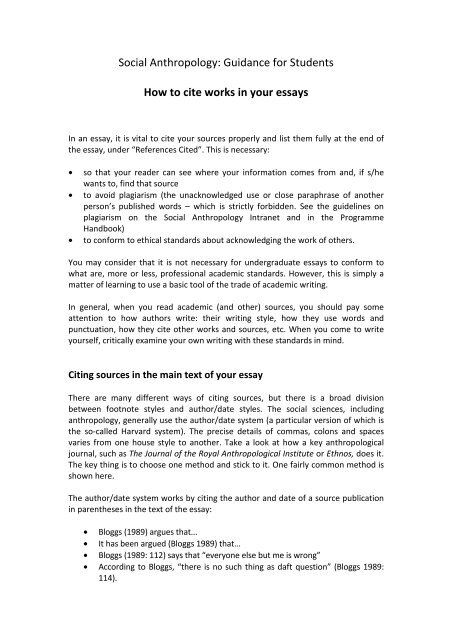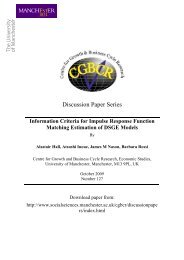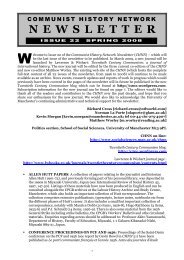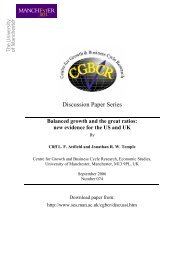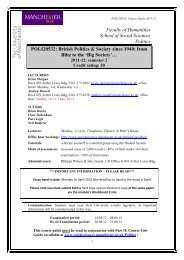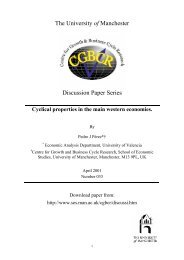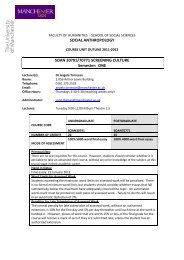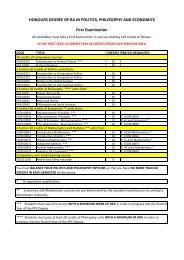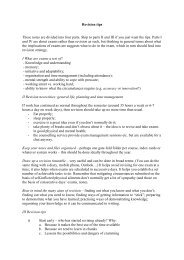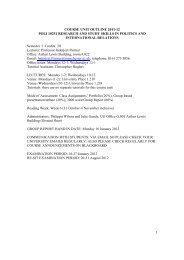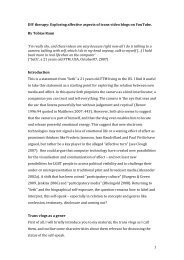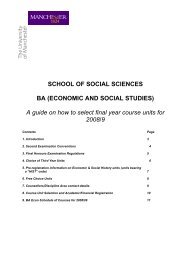Guidance for Students How to cite works in your essays - School of ...
Guidance for Students How to cite works in your essays - School of ...
Guidance for Students How to cite works in your essays - School of ...
You also want an ePaper? Increase the reach of your titles
YUMPU automatically turns print PDFs into web optimized ePapers that Google loves.
Social Anthropology: <strong>Guidance</strong> <strong>for</strong> <strong>Students</strong><br />
<strong>How</strong> <strong>to</strong> <strong>cite</strong> <strong>works</strong> <strong>in</strong> <strong>your</strong> <strong>essays</strong><br />
In an essay, it is vital <strong>to</strong> <strong>cite</strong> <strong>your</strong> sources properly and list them fully at the end <strong>of</strong><br />
the essay, under “References Cited”. This is necessary:<br />
• so that <strong>your</strong> reader can see where <strong>your</strong> <strong>in</strong><strong>for</strong>mation comes from and, if s/he<br />
wants <strong>to</strong>, f<strong>in</strong>d that source<br />
• <strong>to</strong> avoid plagiarism (the unacknowledged use or close paraphrase <strong>of</strong> another<br />
person’s published words – which is strictly <strong>for</strong>bidden. See the guidel<strong>in</strong>es on<br />
plagiarism on the Social Anthropology Intranet and <strong>in</strong> the Programme<br />
Handbook)<br />
• <strong>to</strong> con<strong>for</strong>m <strong>to</strong> ethical standards about acknowledg<strong>in</strong>g the work <strong>of</strong> others.<br />
You may consider that it is not necessary <strong>for</strong> undergraduate <strong>essays</strong> <strong>to</strong> con<strong>for</strong>m <strong>to</strong><br />
what are, more or less, pr<strong>of</strong>essional academic standards. <strong>How</strong>ever, this is simply a<br />
matter <strong>of</strong> learn<strong>in</strong>g <strong>to</strong> use a basic <strong>to</strong>ol <strong>of</strong> the trade <strong>of</strong> academic writ<strong>in</strong>g.<br />
In general, when you read academic (and other) sources, you should pay some<br />
attention <strong>to</strong> how authors write: their writ<strong>in</strong>g style, how they use words and<br />
punctuation, how they <strong>cite</strong> other <strong>works</strong> and sources, etc. When you come <strong>to</strong> write<br />
<strong>your</strong>self, critically exam<strong>in</strong>e <strong>your</strong> own writ<strong>in</strong>g with these standards <strong>in</strong> m<strong>in</strong>d.<br />
Cit<strong>in</strong>g sources <strong>in</strong> the ma<strong>in</strong> text <strong>of</strong> <strong>your</strong> essay<br />
There are many different ways <strong>of</strong> cit<strong>in</strong>g sources, but there is a broad division<br />
between footnote styles and author/date styles. The social sciences, <strong>in</strong>clud<strong>in</strong>g<br />
anthropology, generally use the author/date system (a particular version <strong>of</strong> which is<br />
the so-called Harvard system). The precise details <strong>of</strong> commas, colons and spaces<br />
varies from one house style <strong>to</strong> another. Take a look at how a key anthropological<br />
journal, such as The Journal <strong>of</strong> the Royal Anthropological Institute or Ethnos, does it.<br />
The key th<strong>in</strong>g is <strong>to</strong> choose one method and stick <strong>to</strong> it. One fairly common method is<br />
shown here.<br />
The author/date system <strong>works</strong> by cit<strong>in</strong>g the author and date <strong>of</strong> a source publication<br />
<strong>in</strong> parentheses <strong>in</strong> the text <strong>of</strong> the essay:<br />
• Bloggs (1989) argues that...<br />
• It has been argued (Bloggs 1989) that…<br />
• Bloggs (1989: 112) says that “everyone else but me is wrong”<br />
• Accord<strong>in</strong>g <strong>to</strong> Bloggs, “there is no such th<strong>in</strong>g as daft question” (Bloggs 1989:<br />
114).
Note that when a direct quotation is given, a page number must be supplied. It is<br />
also <strong>of</strong>ten appropriate <strong>to</strong> supply a page number when you are mak<strong>in</strong>g reference <strong>to</strong> a<br />
specific idea <strong>of</strong> piece <strong>of</strong> <strong>in</strong><strong>for</strong>mation from a book or article, rather than a general<br />
argument.<br />
All the sources <strong>cite</strong>d <strong>in</strong> the text <strong>of</strong> the essay are then listed at the end.<br />
<strong>How</strong> <strong>to</strong> <strong>cite</strong> authors who are <strong>cite</strong>d by other authors<br />
If you are cit<strong>in</strong>g an author whose work you have not read first hand but have found<br />
<strong>in</strong> another text, the usual way <strong>of</strong> deal<strong>in</strong>g with this is:<br />
• Bloggs argues that life is an illusion (<strong>cite</strong>d <strong>in</strong> Smith 1990)<br />
• Accord<strong>in</strong>g <strong>to</strong> Bloggs, “life is noth<strong>in</strong>g but pa<strong>in</strong> and misery” (<strong>cite</strong>d <strong>in</strong> Smith<br />
1990: 113).<br />
• A different view is that life is all skittles and beer (Jones, <strong>cite</strong>d <strong>in</strong> Smith 1990)<br />
In this case, it is usual <strong>to</strong> only list Smith under “References Cited”. The reader can go<br />
<strong>to</strong> Smith (1990) and f<strong>in</strong>d the details <strong>for</strong> Bloggs and Jones. It is, however, acceptable<br />
<strong>to</strong> give more detail:<br />
• Accord<strong>in</strong>g <strong>to</strong> Bloggs, “life is noth<strong>in</strong>g but pa<strong>in</strong> and misery” (1985, <strong>cite</strong>d <strong>in</strong><br />
Smith 1990: 113).<br />
In this case, Bloggs (1985) would also be listed at the end.<br />
In general you should avoid cit<strong>in</strong>g and list<strong>in</strong>g authors as if you’d actually read them<br />
first hand when you’ve only encountered them through other texts. This is a<br />
common tactic <strong>to</strong> make it look as if you’ve read more than <strong>your</strong> actually have, but it<br />
is poor practice.<br />
<strong>How</strong> <strong>to</strong> list texts <strong>in</strong> “References Cited”<br />
The best way <strong>to</strong> show this is with examples:<br />
Barkan, Elazar. 1995. Vic<strong>to</strong>rian promiscuity: Greek ethics and primitive exemplars. In<br />
Prehis<strong>to</strong>ries <strong>of</strong> the future: the primitivist project and the culture <strong>of</strong><br />
modernism. Edited by Elazar Barkan and Ronald Bush, pp. 56-92. Stan<strong>for</strong>d:<br />
Stan<strong>for</strong>d University Press.<br />
Barkan, Elazar and Ronald Bush. 1995. Introduction. In Prehis<strong>to</strong>ries <strong>of</strong> the future: the<br />
primitivist project and the culture <strong>of</strong> modernism. Edited by Elazar Barkan and<br />
Ronald Bush, pp. 1-22. Stan<strong>for</strong>d: Stan<strong>for</strong>d University Press.
Bastide, Roger. 1961. Dusky Venus, black Apollo. Race 3: 10-19.<br />
Béhague, Gerard (ed.). 1994. Music and black ethnicity: the Caribbean and South<br />
America. New Brunswick: Transaction Publishers.<br />
Bushnell, David. 1993. The mak<strong>in</strong>g <strong>of</strong> modern Colombia: a nation <strong>in</strong> spite <strong>of</strong> itself.<br />
Berkeley: University <strong>of</strong> Cali<strong>for</strong>nia Press.<br />
Butler, Judith P. 1993. Bodies that matter: on the discursive limits <strong>of</strong> 'sex'. London:<br />
Routledge.<br />
CIIR (Catholic Institute <strong>of</strong> International Relations). 1992. Colombia: image and reality.<br />
London: CIIR.<br />
Hanson, Allan. 1989. The mak<strong>in</strong>g <strong>of</strong> the Maori: culture <strong>in</strong>vention and its logic.<br />
American Anthropologist 91(4): 890-902.<br />
You will note that the list is <strong>in</strong> alphabetical order. The details <strong>of</strong> exactly how <strong>to</strong> set<br />
out the <strong>in</strong><strong>for</strong>mation, particularly punctuation conventions, vary from one house style<br />
<strong>to</strong> another. Nearly all italicise the title <strong>of</strong> books and the names <strong>of</strong> journals. Some<br />
styles do not require page numbers <strong>for</strong> chapters <strong>in</strong> edited books, all require page<br />
numbers <strong>for</strong> journal articles. Aga<strong>in</strong>, the important th<strong>in</strong>g is <strong>to</strong> choose one style and<br />
stick <strong>to</strong> it. Look at an anthropological journal or book <strong>for</strong> examples <strong>of</strong> how <strong>to</strong> list<br />
references.<br />
<strong>How</strong> <strong>to</strong> list Internet sources<br />
References <strong>to</strong> electronic sources <strong>in</strong> the text <strong>of</strong> <strong>your</strong> essay should normally <strong>in</strong>clude<br />
the author’s last name and date. If no author’s name is available, list the web<br />
address. (If the URL is very long and complex, it may be appropriate <strong>to</strong> put it <strong>in</strong> a<br />
footnote.)<br />
Under references <strong>cite</strong>d, an authored Internet source can be listed thus:<br />
Burka, Luis P. 1993. A hypertext his<strong>to</strong>ry <strong>of</strong> multi-user dimensions. MUD his<strong>to</strong>ry.<br />
http://www.u<strong>to</strong>pia.com/talent/lpb/muddex/essay (2 Aug. 1996).<br />
The date at the end is the date you accessed the document.<br />
When <strong>to</strong> use footnotes<br />
In social science styles, footnotes or endnotes are ma<strong>in</strong>ly used <strong>for</strong> additional<br />
<strong>in</strong><strong>for</strong>mation that may be <strong>of</strong> <strong>in</strong>terest <strong>to</strong> some readers, but is not necessary <strong>to</strong> the flow<br />
<strong>of</strong> the ma<strong>in</strong> text. They may give the reader guidance on related literature and<br />
sources. They may also be used <strong>to</strong> give very long lists <strong>of</strong> simple citations that would
otherwise break up the ma<strong>in</strong> text <strong>to</strong>o much. Long and ugly-look<strong>in</strong>g URLs are <strong>of</strong>ten<br />
better located <strong>in</strong> a footnote than <strong>in</strong> the ma<strong>in</strong> text.<br />
Further <strong>in</strong><strong>for</strong>mation<br />
A good clear overall text is:<br />
Pears, Richard and Graham Shields. 2005. Cite them right: the essential guide <strong>to</strong><br />
referenc<strong>in</strong>g and plagiarism. Newcastle Upon Tyne: Pear Tree Books.<br />
For <strong>in</strong><strong>for</strong>mation on how <strong>to</strong> <strong>cite</strong> onl<strong>in</strong>e sources, see Walker, Janice R. and Todd Taylor.<br />
1998. The Columbia guide <strong>to</strong> onl<strong>in</strong>e style. New York: Columbia University Press.<br />
Look at the style guide <strong>for</strong> The Journal <strong>of</strong> the Royal Anthropological Institute<br />
http://onl<strong>in</strong>elibrary.wiley.com/journal/10.1111/(ISSN)1467-<br />
9655/homepage/ForAuthors.html<br />
Or the follow<strong>in</strong>g website has details <strong>of</strong> how <strong>to</strong> reference different k<strong>in</strong>ds <strong>of</strong> <strong>works</strong><br />
and media us<strong>in</strong>g the Harvard system<br />
http://community.ucreative.ac.uk/article/25881/Referenc<strong>in</strong>g-specific-sources-us<strong>in</strong>gthe-Harvard-style<br />
Insert<strong>in</strong>g an Au<strong>to</strong>mated Word Count<br />
1. Click the Insert tab on the Ribbon.<br />
2. In the Text group, click the QuickParts icon.<br />
3. Click the Fields menu item.<br />
4. Scroll down <strong>to</strong> and click on NumWords.<br />
5. Click OK.


